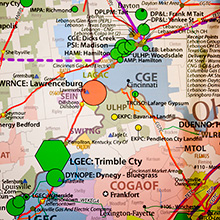Location Analytics: Bringing Geography Back
“Without being Orwellian about it, your credit card and the information people have about you is like a little GPS tracker,” says Simon Thompson of Esri, a California company that provides geographic information system technology. “When you start mining geospatial data, these patterns become highly relevant.”
Topics
Competing With Data & Analytics

Simon Thompson, Director of Global Business Solutions at Esri
Remember geography lessons in school, painstakingly memorizing the longest rivers, cultures of various regions, the state capitals? For most of us, those lessons are in the past. But in the world of big data analytics, geography is making a comeback.
The relatively new market of location analytics is expanding the uses of more traditional geographic information system (GIS) technology to include social, geographic, physical and emotional indicators that help organizations better predict trends, according to ABI Research, which forecasts that the location analytics market will grow to $9 billion by 2016.
This isn’t news to some of the world’s largest technology companies — Apple, Google, Nokia, Facebook, Microsoft and, most recently, Cisco — each of which has snapped up location related analytics vendors in the past year.
In a conversation with MIT Sloan Management Review contributing editor Renee Boucher Ferguson, Simon Thompson, Director of Global Business Solutions at Esri, a Redlands, Calif. based GIS provider, discusses the future of location analytics and why it’s relevant to organizations today.
Can you talk a little bit about geospatial technology, where location analytics fits in, and how it is being used?
Geospatial data and geospatial technology have been around for 30-plus years. And really the basis of it is about exploiting the idea of connections based on the location of things: Why they got there, how they got there and what does this mean to society and to business.
In the early days, a lot of geospatial technology was about collecting information. So local governments realized that if they understood the roads, and then if they understood how the houses connected to those roads and the property lines and the parcel information, and then the values of the houses and how they were connected to the sewers, and then where the rivers were that might flood, or the population age of the people living in those houses — if they had all that information, they could provide better services.
About 20 years ago, there was a significant shift. Companies started to think about geospatial technology in terms of retail site selection. How do I, as Macy’s, plan the best place for stores? How does Starbucks pick its locations?
What we’ve seen over the last five years is an explosion of the use of geospatial data and location analytics in the commercial market. You can think of the way that we interact like being an ant farm of actions and transactions. Every transaction that goes into a point of sale system is not only recording something about the buyer and something about the product, but it’s actually recording the relationship between those two things. So if I, as a retailer, can backtrack to where the person making a purchase came from, I can make a connection to the type of transaction they’re doing.
Ultimately, without being Orwellian about it, your credit card and the information people have about you is like a little GPS tracker. An aggregator, for example, can discover that I went out to Joseph A. Banks and I bought two suits. And then I went to Marshalls and I bought a pair of new shoes. Then I went to Target and I bought the latest J.D. Robb novel. An aggregator can discover that I did one on the way to the office and then I went out at lunchtime and bought the J.D. Robb book. But then I discovered the sale at Joseph A. Banks and took advantage of proximity to that. So it wasn’t a planned activity. When you start mining geospatial data, these patterns become highly relevant.
There is a real capability to use mapping and location analytics to zoom in — to really put a lens on top of your data that says, “tell me something about this with these characteristics in terms of the who, the what, the when.” Then you try to understand the why, and use the where as the framework for all of those other questions that you want to ask.
What sorts of data do you tap to get to insights from location analytics?
Well, there are so many different places. The census data has always been incredibly important but now it’s easy for people to combine their own internal information with other public and private data sources. Companies mine their own databases, mine their loyalty systems, mine their CRMs, mine tweets, social media, customer transactions, market surveys. They link data using geography to give them better insight about what people are doing where, who those people are and why they are there in the first place.

An Esri map of the North American Natural Gas system that takes an in-depth look at the supply, transportation, and demand aspects of the evolving natural gas market place.
So there are many, many, many different sources of information that people are using to create a maps of interactions, needs and supply and demand, with thousands of different variables which can literally be used to answer millions of questions. Probably the most interesting at the moment is social media.
What is interesting about social media data? What are the implications of all this relatively new information for organizations doing location analytics?
Social media is in the inflection point of so many trends in computing and information science. It’s big data, arriving in real-time, and it’s crowd sourced. It’s totally unstructured yet full of sentiment and truly valuable data if you can connect it. These atoms of data can validate axioms. It’s reopening up the importance of tactic knowledge and heuristic understanding.
Social media is the ultimate data source to test what you know or think you know by using intelligent guesswork rather than by following some pre-established formula. This is the idea of Know By Trying — it’s what we’ve been doing in GIS for 30 years the ideas of asking and testing What If?
You mentioned Orwellian, which begs the question: How many of Esri’s customers are using location analytics to determine customer movements?
Thousands; in fact, we’re probably approaching hundreds of thousands. But what they are doing isn’t Orwellian. They’re not tracking individuals; they’re using the data that they have on an aggregate level, from their own business system, in a better way to make a bigger difference.
One of the biggest uses at the moment is in retail to integrate clicks and bricks, or online activities to our offline experience in stores. But the idea of improving wallet share and optimal efficiency through location analytics is really driving all of our customers.
Say I’m a large pharmacy and I said to my shareholders that I’m going to open 60 new stores across the U.S. in 2012. Well, that’s a lot of capital that I’m going to invest. If I can use location analytics to understand the traffic flows and demographics, I can actually analyze the population and make predictions about prescription medicine. I can make predictions about how many scripts I’ll write, where they will come from, who is that audience and what other products they might buy, because of that demographic profile. All of these things I can use to start to really look at revenues from different business areas and how they impact the type of store I need.
You can then start to clearly understand the sales potential against the cost to build and operate. I can then look at sites by saying, “if I know what my fixed overheads are from a financial position, I can actually calculate the total volume of sales or customers within the market area that I need to make this site profitable.” I can do this repeatedly across different locations and space configurations until I find the best one that meets all those requirements and drivers.
What we see is that real estate brokers, developers and retailers understand location analytics. But it’s an underreported part of business whose importance is sometimes undervalued.
Why do you think this type of analytics is largely undiscovered?
As soon as you say geography, half your audience basically zones out. We need to differentiate between location, where something is, and geography, which describes the context it is in. With the context, you get facts that provide a narrative which leads to comprehension and understanding.
Historically, location analytics has not been embedded within large-scale data investment tools, it’s been off to the side so both GIS and BI or other enterprise systems have suffered.
I think the other challenge has been that over the last 20 years, when you talk about IT projects, technologists think big on the T (technology) and little on the I (information). What IT has tended to do is create wonderful technology platforms, but there has been a lack of investment on the information acquisition and management part of that.
What’s really happening now is technology has come to a point that the complexity of the data has driven the technology to transform. We’ve got in memory databases that can handle billions and billions of transactions. The technology we invested in is enabling a new perception of data and information. Big data comes with a very wooly definition; we don’t know whether it’s defined by data transactions or size or number of files or even number of databases. But big data comes with a common set of problems and opportunities.
Whichever way we look at it, we’re connecting data sets together and we’re reducing them and finding those nuggets of information that we can act on. We can find actionable intelligence and business insight.
So how does location analytics fit into the “big data” movement?
What’s happening in terms of technology is that all of these big data capabilities, the increase in computing performance, things like MapReduce and others capabilities like it, have made it possible to handle incredibly large amounts of structured and unstructured data. Geographic context would typically be the unstructured part, or the least structured part, of data.
What we’re now able to do is use geographic data and analysis to connect these different data sets together. If you’re a bank you can say, “here’s a common key that can connect a unique customer ID to other unique customer IDs.” Suddenly you can see what accounts Bob has and his family has. Now you have a household, and you can treat it as such, rather than a set of five or six individual accounts, which, by happenstance, are located at the same place. They have neighbors and where they live tells us more about them and their habits. Is Bob like his neighbors or different? If Bob is a valuable customer and he’s like his neighbors I can use this knowledge to attract new customers and perhaps create new products to meet needs and opportunities I didn’t know existed.
And we all know, in this example, that there is no such thing as happenstance. So what you’re seeing in banking, for example, is that people completely change their view of what’s important, from an analytics perspective. The unique customer ID and the account number we’ve all lived with for years — that’s a secondary element in the analytics now. The important elements are things like households, the individual, how they match or differ from their neighbors and how you join internal data analytics with external information.
Is there a privacy component that organizations need to be aware of with this type of analytics?
Yes. Clearly there’s a danger that you take customer insight too far and one of your actions will intersect in a way that you didn’t intend. There’s a recent example in which a mass merchant sent a young woman a coupon for diapers before her family knew she was expecting. That shows how good the understanding of the individual is. But I think most people would question if there were appropriate filters on the information. That, to me, is a failure in the logic within the business. They disconnected the logic from the operations.
To me the real essential value of location analytics is that you use insight for good, to benefit individuals and society as a whole. You can use any number of technologies to mine data streams and connect all this data together. You can say, “I can track everything that a person is doing and everywhere that he’s been. I can find his Twitter handle and his Facebook and his friends and everything else and bring it all together, to know everything about that person.” But the question is not what you can do with the information about that person, but what can you do for him?
When you help design a mapping system for a customer, do you help define those parameters that could, in practice, be construed as intrusive?
We find that a lot of organizations understand that intrusiveness, and we do a lot of work to make sure we comply with all the systems and governance they have in place. In the end, what we show organizations is that there is so much of a business advantage to be had by understanding things in the aggregate, that trying to deal with individuals doesn’t really bring you that much business benefit.
What we’re seeing is that our customers are not focusing on the individual, not getting in that Orwellian space, but focusing on segments and categories, cohorts and customer needs. We tend to talk about the importance of understanding the power of place and what you can gain by knowing more about the place and the people in it.





Comments (2)
Location Analytics Meets Big Data « Right Place_Real Time
Will Location Analytics Change How Midsize Interacts With Customers? | Egypt